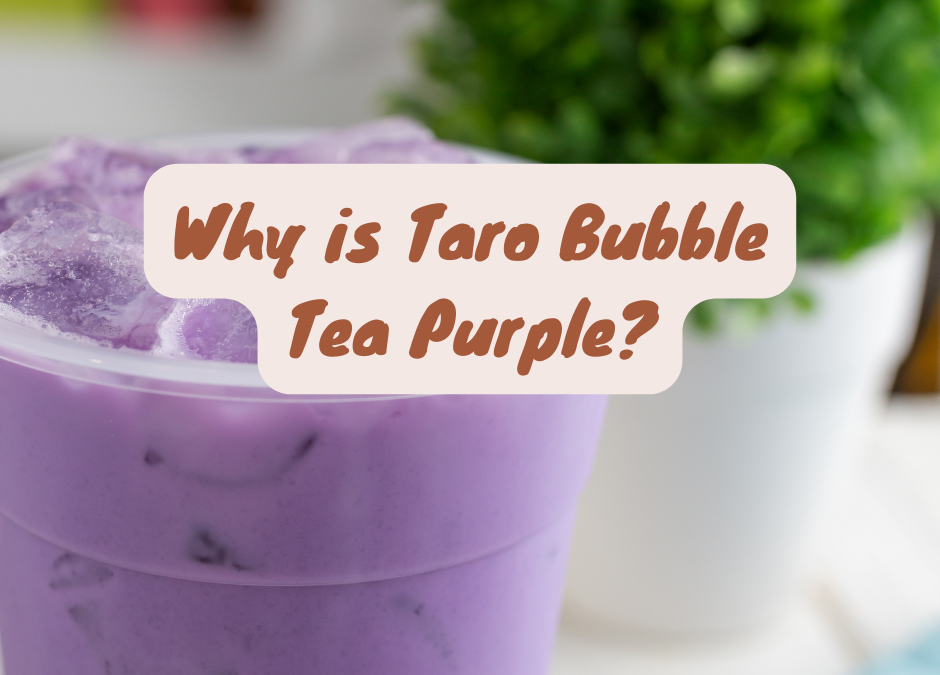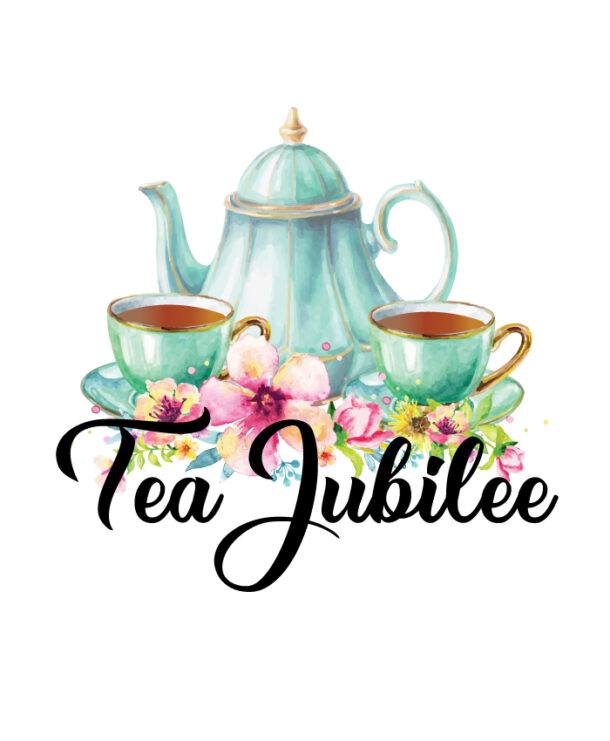==================
A Caveat and Affiliates
First off, a little caveat: within my articles you will find affiliate links, meaning if you buy them, I get a small commission. Your cost is not affected. In addition, I am an Amazon Associate and I earn from qualifying purchases on Amazon.
And yes, if I say that I recommend a product here, it means I truly believe it is a good product. I refuse to recommend any product that I have not researched and believe to be a good value.
Even better, I provide you with a very clear picture of the product, it’s use, and the probable value.
Earning your trust is important to me. I run this website myself and the commissions and donations help support the site.
Sound reasonable and fair enough? Let’s continue to the article.
==================
Contents
Why is Taro Bubble Tea Purple, and What Does it Taste Like?
Why is Taro Bubble Tea Purple? That is a question we have been asking ourselves. Hmm..we have just the article you’re looking for!
Introduction to Taro Bubble Tea
Have you ever wondered why Taro Bubble Tea is purple and what it tastes like? This unique beverage has gained popularity worldwide, captivating taste buds with its vibrant color and distinct flavor. In this article, we will delve into the origins and history of Taro Bubble Tea, explore why it is purple, and uncover the delightful taste that awaits those who venture to try it.
The Origin and History of Taro Bubble Tea
Taro Bubble Tea, also known as Taro Boba Tea, originated in Taiwan in the 1980s. It was created by adding chewy tapioca pearls, also known as boba, to a mixture of brewed tea, milk, and taro paste. The combination of these ingredients resulted in a refreshing and visually appealing beverage that quickly became a sensation.
Taro Bubble Tea spread from Taiwan to other parts of Asia and eventually gained popularity worldwide. It became a staple in many bubble tea shops, captivating both locals and tourists with its unique taste and appearance. Today, Taro Bubble Tea can be found in various forms and flavors, satisfying the cravings of bubble tea enthusiasts everywhere.
What is Taro, and Why is it Purple?
Taro, the main ingredient in Taro Bubble Tea, is a root vegetable native to Southeast Asia. It belongs to the Araceae family and is known for its starchy texture and nutty flavor. Taro is widely used in Asian cuisine, often in desserts and beverages, due to its natural sweetness.
The purple color of Taro comes from the naturally occurring pigments known as anthocyanins. These pigments give Taro its vibrant hue, ranging from light lavender to deep purple. Anthocyanins provide the visual appeal of Taro Bubble Tea and offer potential health benefits, as they are known for their antioxidant properties.
Taro vs Ube: Understanding the Difference
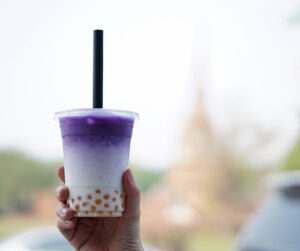
Taro is often confused with Ube due to their similar purple appearance. However, they are distinct ingredients with different flavors and origins. As mentioned earlier, Taro is a root vegetable from Southeast Asia. On the other hand, Ube, also known as purple yam, is a tuberous root vegetable native to the Philippines.
While both Taro and Ube are purple, Taro has a nutty and mildly sweet flavor, while Ube has a sweeter and more distinct taste. Taro is often used in beverages such as Taro Bubble Tea, while Ube is commonly used in Filipino desserts like Ube Halaya and Ube Ice Cream. The unique flavors and characteristics of both Taro and Ube contribute to the diversity of culinary delights around the world.
Exploring the Taste of Taro Bubble Tea
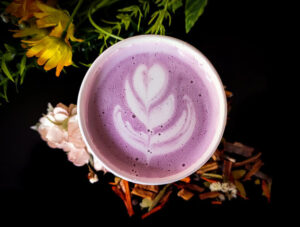
Now, let’s dive into the tantalizing taste of Taro Bubble Tea. Combining brewed tea, milk, taro paste, and chewy tapioca pearls creates a symphony of refreshing and satisfying flavors. The taro paste adds a creamy and slightly nutty undertone, enhancing the overall taste profile of the beverage.
You can expect a delightful balance of sweetness and earthiness when sipping Taro Bubble Tea. The sweetness comes from the taro paste and any additional sweeteners added to the drink. The earthy notes, characteristic of Taro, provide a unique and comforting flavor that sets Taro Bubble Tea apart from other bubble tea variations.
The chewy tapioca pearls, often referred to as boba, add an enjoyable textural element to the drink. As you sip through the straw, the pearls provide a satisfying burst of texture, complementing the smoothness of the taro-infused liquid. The overall experience of drinking Taro Bubble Tea is a delightful adventure for your taste buds.
Taro in Other Culinary Delights – Taro Ice Cream
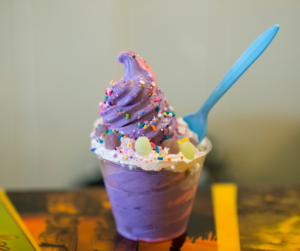
Apart from Taro Bubble Tea, Taro also shines in other culinary delights, one of which is Taro Ice Cream. Taro Ice Cream has become increasingly popular in recent years, captivating ice cream enthusiasts with its unique flavor and vibrant color.
Taro Ice Cream is made by incorporating taro paste or taro powder into the ice cream base. This results in a creamy and smooth ice cream with a distinct taro flavor. The purple color adds to the visual appeal, making Taro Ice Cream a delightful treat for both the eyes and the palate.
Whether enjoyed on its own or alongside other flavors, Taro Ice Cream offers a refreshing and indulgent experience. Its mild sweetness and nutty undertones make it a perfect choice for those seeking a unique twist on traditional ice cream flavors.

How to Make Taro Bubble Tea at Home
If you are a fan of Taro Bubble Tea and want to enjoy it in the comfort of your own home, fear not! Making Taro Bubble Tea is easier than you might think. Here’s a simple recipe to get you started:
Ingredients:
- 2 cups brewed black tea
- 1 cup milk (dairy or non-dairy alternative)
- 1/2 cup taro paste or taro powder
- Sweetener of your choice (optional)
- Cooked tapioca pearls (boba)
- Ice cubes
Instructions:
- Combine the brewed black tea, milk, taro paste or powder, and sweetener (if desired) in a blender. Blend until well-mixed and smooth.
- Add ice cubes to fill a glass with cooked tapioca pearls (boba).
- Pour the taro mixture over the tapioca pearls and ice.
- Stir well to ensure the flavors are evenly distributed.
- Insert a wide straw into the glass and enjoy your homemade Taro Bubble Tea!
Feel free to experiment with different ratios and ingredients to suit your taste preferences. Making Taro Bubble Tea at home allows you to customize the sweetness and richness according to your liking, ensuring a truly personalized beverage.
Where to Find the Best Taro Bubble Tea
Fear not if you’re not in the mood to make Taro Bubble Tea at home! There are numerous bubble tea shops and cafes where you can indulge in this delightful beverage. Taro Bubble Tea has become a popular menu item in many places, from local shops to well-known chains.
To find the best Taro Bubble Tea near you, consider exploring local Asian neighborhoods or searching online for bubble tea shops in your area. Reading reviews and asking for recommendations from friends or fellow bubble tea enthusiasts can also help guide you to the most authentic and delicious Taro Bubble Tea experience.
Taro Bubble Tea Variations and Flavors
While the classic Taro Bubble Tea remains a favorite among many, various variations and flavors exist to explore. Bubble tea shops often offer creative twists on the traditional recipe, incorporating different ingredients and flavors to cater to diverse preferences.
Some popular Taro Bubble Tea variations include Taro Coconut Bubble Tea, Taro Matcha Bubble Tea, and Taro Mango Bubble Tea. These variations add an extra layer of complexity to the flavor profile, combining the unique taste of Taro with other complementary ingredients. Exploring these variations allows you to discover new taste sensations and expand your bubble tea repertoire.
Conclusion: Embracing the Unique Taste of Taro Bubble Tea
In conclusion, Taro Bubble Tea is a delightful beverage that captivates both the eyes and the palate. Its vibrant purple color, derived from the natural pigments in Taro, adds to its visual appeal. The nutty and slightly sweet flavor of Taro, combined with the creamy texture and chewy tapioca pearls, creates a truly unique taste experience.
Whether you choose to enjoy Taro Bubble Tea at a local bubble tea shop or decide to make it at home, embracing the unique taste of Taro Bubble Tea is an adventure in itself. So next time you find yourself craving a refreshing beverage with a twist, give Taro Bubble Tea a try and let your taste buds be enchanted by its magical flavors. Cheers to the wonders of Taro Bubble Tea!
Are you ready to embark on a Taro Bubble Tea adventure? Visit your local bubble tea shop or try making it at home using our simple recipe. Don’t miss out on the delightful flavors and vibrant colors of Taro Bubble Tea.
More From Tea Jubilee.
Taro milk tea (not our post)
And that’s all for this article. Thank you so much for reading our post about why Taro Bubble Tea is purple. We hope you’ll stop by again very soon to learn more about teas.
Have a great day!


